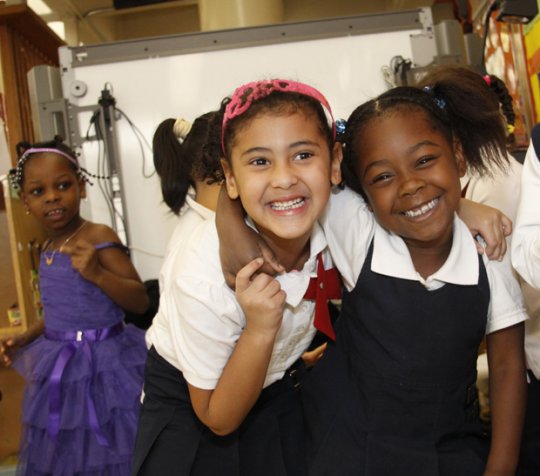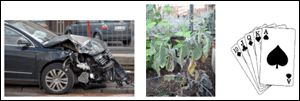Unit 4: Lesson 7
Read “Wendell” in Seedfolks; Investigate & Annotate the Text & Reflect
LITERACY OBJECTIVE
By the end of this lesson students will be able to identify clues in the text that inform the reader about the character and annotate the text to track questions and thoughts while reading.
LITERACY "I CAN" STATEMENT
"I can identify clues in the story that tell me about the character and make notes about the things I am thinking while I read."
LESSON OVERVIEW
| Steps |
Pacing: 45-60 Minutes |
|
|
30 Minutes |
|
|
15-30 Minutes |
Standards Alignment
Reading Standards (Literature)
RL 3.1: Ask and answer questions to demonstrate understanding of a text, referring explicitly to the text as the basis for the answers.
RL 3.2: Recount stories, including fables, folktales, and myths from diverse cultures; determine the central message, lesson, or moral and explain how it is conveyed through key details in the text.
RL 3.3: Describe characters in a story (e.g., their traits, motivations, or feelings) and explain how their actions contribute to the sequence of events.
RL 4.1: Refer to details and examples in a text when explaining what the text says explicitly and when drawing inferences from the text.
RL 4.2: Determine a theme of a story, drama, or poem from details in the text; summarize the text.
RL 4.3: Describe in depth a character, setting, or event in a story or drama, drawing on specific details in the text (e.g., a character’s thoughts, words, or actions).
Writing & Language
W 4.9a: Apply grade 4 Reading standards to literature (e.g., “Describe in depth a character, setting, or event in a story or drama, drawing on specific details in the text [e.g., a character’s thoughts, words, or actions].”).
W 5.9a: Apply grade 5 Reading standards to literature (e.g., “Compare and contrast two or more characters, settings, or events in a story or a drama, drawing on specific details in the text [e.g., how characters interact]”).
Speaking & Listening
SL 3.1a: Come to discussions prepared, having read or studied required material; explicitly draw on that preparation and other information known about the topic to explore ideas under discussion.
SL 3.1b: Follow agreed-upon rules for discussions (e.g., gaining the floor in respectful ways, listening to others with care, speaking one at a time about the topics and texts under discussion).
SL 3.1c: Ask questions to check understanding of information presented, stay on topic, and link their comments to the remarks of others.
SL 3.1d: Explain their own ideas and understanding in light of the discussion.
SL 3.2: Determine the main ideas and supporting details of a text read aloud or information presented in diverse media and formats, including visually, quantitatively, and orally.
SL 3.3: Ask and answer questions about information from a speaker, offering appropriate elaboration and detail.
SL 3.6: Speak in complete sentences when appropriate to task and situation in order to provide requested detail or clarification.
SL 4.1a: Come to discussions prepared, having read or studied required material; explicitly draw on that preparation and other information known about the topic to explore ideas under discussion.
SL 4.1b: Follow agreed-upon rules for discussions and carry out assigned roles.
SL 4.1c: Pose and respond to specific questions to clarify or follow up on information, and make comments that contribute to the discussion and link to the remarks of others.
SL 4.1d: Review the key ideas expressed and explain their own ideas and understanding in light of the discussion.
SL 4.2: Paraphrase portions of a text read aloud or information presented in diverse media and formats, including visually, quantitatively, and orally.
SL 4.3: Identify the reasons and evidence a speaker provides to support particular points.
SL 4.6: Differentiate between contexts that call for formal English (e.g., presenting ideas) and situations where informal discourse is appropriate (e.g., small-group discussion); use formal English when appropriate to task and situation.
SL 5.1a: Come to discussions prepared, having read or studied required material; explicitly draw on that preparation and other information known about the topic to explore ideas under discussion.
SL 5.1b: Follow agreed-upon rules for discussions and carry out assigned roles.
SL 5.1c: Pose and respond to specific questions by making comments that contribute to the discussion and elaborate on the remarks of others.
SL 5.1d: Review the key ideas expressed and draw conclusions in light of information and knowledge gained from the discussions.
SL 5.2: Summarize a written text read aloud or information presented in diverse media and formats, including visually, quantitatively, and orally.
SL 5.3: Summarize the points a speaker makes and explain how each claim is supported by reasons and evidence.
SL 5.6: Adapt speech to a variety of contexts and tasks, using formal English when appropriate to task and situation.
Reading Standards (Literature)
RL 3.10: By the end of the year, read and comprehend literature, including stories, dramas, and poetry, at the high end of the grades 2–3 text complexity band independently and proficiently.
RL 4.10: By the end of the year, read and comprehend literature, including stories, dramas, and poetry, in the grades 4–5 text complexity band proficiently, with scaffolding as needed at the high end of the range.
RL 5.1: Quote accurately from a text when explaining what the text says explicitly and when drawing inferences from the text.
RL 5.10: By the end of the year, read and comprehend literature, including stories, dramas, and poetry, at the high end of the grades 4–5 text complexity band independently and proficiently.
Writing & Language
W 3.4: With guidance and support from adults, produce writing in which the development and organization are appropriate to task and purpose.
W 3.10: Write routinely over extended time frames (time for research, reflection, and revision) and shorter time frames (a single sitting or a day or two) for a range of discipline-specific tasks, purposes, and audiences.
W 4.4: Produce clear and coherent writing in which the development and organization are appropriate to task, purpose, and audience.
W 4.10: Write routinely over extended time frames (time for research, reflection, and revision) and shorter time frames (a single sitting or a day or two) for a range of discipline-specific tasks, purposes, and audiences.
W 5.4: Produce clear and coherent writing in which the development and organization are appropriate to task, purpose, and audience.
W 5.10: Write routinely over extended time frames (time for research, reflection, and revision) and shorter time frames (a single sitting or a day or two) for a range of discipline-specific tasks, purposes, and audiences.
L 3.1: Demonstrate command of the conventions of standard English grammar and usage when writing or speaking.
L 3.2: Demonstrate command of the conventions of standard English capitalization, punctuation, and spelling when writing.
L 4.1: Demonstrate command of the conventions of standard English grammar and usage when writing or speaking.
L 4.2: Demonstrate command of the conventions of standard English capitalization, punctuation, and spelling when writing.
L 5.1: Demonstrate command of the conventions of standard English grammar and usage when writing or speaking.
L 5.2: Demonstrate command of the conventions of standard English capitalization, punctuation, and spelling when writing.
SL 5.3: Summarize the points a speaker makes and explain how each claim is supported by reasons and evidence.
SL 5.6: Adapt speech to a variety of contexts and tasks, using formal English when appropriate to task and situation.
Teaching Resources
-Reading Like a Detective Chart
-Music Instruments and Stations
Unit 5 includes the following Life & Learning Skills:
-Reflective thinking
-Creative problem-solving
-Critical and analytic thinking
-Collaboration Communication
 Differentiation Options
Differentiation Options
Differentiation Options will appear throughout the unit to suggest ways to scaffold or challenge student learning. Use the number of helping hands to select the level of differentiation that best supports student learning.


 Highest level of scaffolding. Select this option if students are learning strategies for the first time, if the text is challenging for them, or if students require more guidance during activities. Part 1 lessons are written for the highest level of scaffolding.
Highest level of scaffolding. Select this option if students are learning strategies for the first time, if the text is challenging for them, or if students require more guidance during activities. Part 1 lessons are written for the highest level of scaffolding.

 Moderate scaffolding. Select this option if students require some support comprehending the text or navigating the activity.
Moderate scaffolding. Select this option if students require some support comprehending the text or navigating the activity.

Least amount of scaffolding/Extending the instruction. Select this option if students are ready to work more independently, move more quickly through the material, or are ready for additional challenge.
 Leveraging Moments
Leveraging Moments
Key instructional steps where the arts are used to leverage literacy-learning (and vice versa) are marked with  . Smaller leveraging moments also occur throughout the lessons.
. Smaller leveraging moments also occur throughout the lessons.
Process: Give an overview of the lesson objectives: Read “Wendell” and investigate and annotate the text.
Differentiation Option: Visual Arts And Writing
In the visual arts alterative for Wendell, the students will read and annotate the Text and will complement that written annotation with a visual gesture drawing after reading each excerpt 1, 2 and 3. They will also add those gesture drawings to the Seedfolks Character Chart for Wendell.
Process for using Visual Arts as the art form to respond to Wendell
- As in the previous character chapter (Ana), eliminate the Notation Chart and have students respond to the Question for Wendell’s Theme: “What characteristic, emotion, and/or change are you showing through your gesture drawings?” (Replacement on pg. 17 of Student Notebook)
- Using quick gesture drawings and symbolic lines and shapes, students will first do a series of quick linear gesture drawings in the Seedfolks Character Chart for Wendell to illustrate his character traits. This activity is in response to the student’s annotations on Wendell in the text and can replace “What sounds can you use to represent Wendell’s feelings and transformation?”(pg. 5 on the Seedfolks Character Chart in the A4L Student Notebook).
- The gesture drawings should be very quick sketches in response to their reading and reflecting upon each annotated section of the chapter as currently distinguished at reflection points where students are instructed to pause and make written annotations to the text.
- At the end of the chapter on Wendell (and in each subsequent chapter and introduction of a new character), the students are asked to summarize their inferences in writing in the Reflection Chart in the Student Notebook. This activity requires that students synthesize their annotations and inferences and explain verbally describe the character traits for that character. It will also require them to visualize, synthesize and illustrate those characteristics with a visual gesture drawing.
- The Notation Chart will not be used and in the section on the Composer’s Questions – Wendell Theme (pg. 17 of the A4L Student Notebook), students will substitute drawing for music. E.g. instead of “What characteristic, emotion, and/or change are we showing through music?” the student will describe that change through their visual images. The other questions are not applicable to a visual arts activity.
- Students will contrast their visual gestures for Kim, Ana and Wendell and will describe those differences in writing.
ELL Support: Comprehensible Input
Support ELL language development and comprehension by starting with a short vocabulary lesson using Vocabulary Snapshots to provide multi-sensory pre-learning for words that may be unfamiliar to culturally diverse students.
Click for a sample lesson plan.
Recommended vocabulary from “Wendell” to pre-teach with Vocabulary Snapshots:
- Car Wreck - Leaves Like Spades
- Deck of Cards - Wilted
Sample Visual Icons
See Unit 4 Texts,
pages 25-26 (students) and this
resource page (teachers) for Vocabulary Snapshot activities using these visual icons and more.
Suggested Dialogue
"Today we’re going to read the third chapter of Seedfolks, by Paul Fleishman titled 'Wendell'.”
"By the end of today’s lesson, you will be able to say, 'I can identify clues in the story that tell me about the character and make notes about the things I am thinking while I read'.”
Process: Guide students to sit in Seedfolks Ensembles with their A4L Texts. Tell students to wait for the “Go” signal to being moving. Read “Wendell,” Excerpt 1. Either read the excerpt aloud all the way through or send students into independent reading. Then have students work in pairs to reread closely, asking “I wonder” questions and looking for clues that tell the reader what the character is thinking, feeling, or doing. Prompt pairs to record their questions, clues, and ideas in their A4L Texts on
page 8.
See menu below, Differentiation Options: Reading & Annotating “Wendell,” to scaffold students appropriately.
 Differentiation Options: Reading & Annotating "Wendell"
Differentiation Options: Reading & Annotating "Wendell"
Select one of the options listed below or structure the reading in a way that appropriately meets students’ needs and fosters engagement. Read More...
ELL Support: For all options, allow ELL to use native language and/or picture dictionaries as vocabulary and concept clarifiers. Students may also benefit from listening to a taped recording of the story to build understanding before reading and annotating on their own.


 Guide Excerpts 1, 2, and 3. Facilitate the class reading and annotating all 3 excerpts, guiding students to ask questions, identify clues, and record ideas. Either read the text aloud while students follow along or have students read independently.
Guide Excerpts 1, 2, and 3. Facilitate the class reading and annotating all 3 excerpts, guiding students to ask questions, identify clues, and record ideas. Either read the text aloud while students follow along or have students read independently.

 Guide Excerpt 1. Students read Excerpts 2 and 3 in pairs. Guide students to read and annotate Excerpt 1. Then have students work in excerpt in pairs for Excerpts 2 & 3 with class discussion following. Some students can read in pairs while others read with support from the teacher.
Guide Excerpt 1. Students read Excerpts 2 and 3 in pairs. Guide students to read and annotate Excerpt 1. Then have students work in excerpt in pairs for Excerpts 2 & 3 with class discussion following. Some students can read in pairs while others read with support from the teacher.
 Students read and annotate independently.
Students read and annotate independently. Talk through the “Reading Like a Detective Process” and then have students read & annotate each excerpt independently with class discussion following.
Read like a detective by asking good questions and looking for clues that will help you make meaning.
Record a “?” next to the text to mark places you have an “I wonder” question. You might wonder about:
Something that confuses you: I wonder who shot Wendell’s son.
Something that you find curious or interesting: I wonder why it says that he jerks when the phone rings.
Something that you think might happen next: I wonder what Wendell will plant.
Something that connects two characters: I wonder if Wendell and Kim will become friends.
Circle clues in the text that tell you what the character is:
Thinking
Feeling
Ask yourself: “What do these clues tell me about the character? What in the text makes me think that?” Write notes in the margin.
Suggested Dialogue
Reading “Wendell” and Annotating the Text
"Open your A4L Texts to page 8. We’ll read the first part of 'Wendell.” What can you say about Wendell from the pictures on this page?" (Display Excerpt 1, page 8 from A4L Texts on the document camera. Students respond. Read Excerpt 1 aloud.)
"Let’s review, how do we read like detectives? (Students respond “ask questions,” “look for clues about what the character is thinking, feeling, and doing,” or “write ideas in the text.”) Work with a partner. Reread the first paragraph and then stop and talk together about the questions you have, the clues you found, including any about other characters, and what they tell you about Wendell. Circle the clues, write “?” next to the spots you have a question, and write your ideas in the margin." (Students work in pairs to read and annotate the first paragraph. Circulate to check in with pairs as they work. Repeat the process for the second paragraph.)
Leading a Whole Class Discussion
"Let’s talk about what you wondered and learned from this excerpt. Who wants to share an 'I wonder” or a clue?' (Students may ask, “I wonder who shot Wendell’s son,” “I wonder if Ana and Wendell are friends,” “I wonder why it says that he jerks when the phone rings,” and “I wonder if Ana is talking about Kim’s beans.” Discuss “I wonder” questions and answer if possible. Clues might include, “Wendell’s son and wife are dead,” “Wendell and Ana are white,” “Wendell is mad at Ana,” “Wendell and Ana think Kim is Chinese,” or “Wendell knows about plants.” Support students to make inferences by asking, “What makes you think that?” and “What does this tell you about Wendell?” Direct students back to the text as needed.)
Process: Read “Wendell,” Excerpt 2. Read the excerpt all the way through or have students work independently. Have students work in pairs to reread closely, asking “I wonder” questions, looking for clues that tell the reader what the character is thinking, feeling, or doing, and making connections with other characters in the story. Prompt pairs to record their questions, clues, and ideas in their A4L Texts on
page 9.
See menu above Differentiation Options: Reading & Annotating “Wendell” (Step 2) to scaffold students appropriately.
Suggested Dialogue
Reading “Wendell” Excerpt 2
"Open your A4L Texts to page 9. We’ll read the next part of the chapter." (Display Excerpt 2, page 9 in A4L Texts, on the document camera. Read Excerpt 2 aloud.)
Reread Excerpt 2 & annotate the text.
"Work with your partner to reread this part of the story. Ask “I wonder” questions.
Look closely for clues about what the character is thinking, feeling, and doing, and for clues about other characters. Reread each paragraph and then stop and talk together about the questions you have, the clues you found, and what they tell you about Wendell. Circle the clues, write “?” next to the spots you have a question, and write your ideas in the margin." (Students work in pairs to read and annotate each paragraph. Circulate to check in with pairs as they work.)
Whole class discussion.
"Let’s talk about what you wondered and learned from this excerpt. Who wants to share an “I wonder” or a clue?" (Students may ask, “I wonder if Wendell was a janitor,” “I wonder what it means when it says, ‘you’d have thought that those beans were hers,’” “I wonder what Wendell thinks about Ana,” “I wonder what Kim was thinking when she saw Wendell,” and “I wonder why Wendell didn’t talk to Kim.” Discuss “I wonder” questions. Show images from Resources, page 48 to clarify terms as needed. Clues might include “Wendell waters Kim’s beans,” “Wendell knows about plants,” “He doesn’t like being bossed around,” or “Wendell sees Kim and smiles at her. He is kind.” Support students to make inferences by asking, “What makes you think that?” and “What does this tell you about Wendell?” Direct students back to the text as needed.)
Process: Read “Wendell,” Excerpt 3. Read the excerpt all the way through or have students work independently. Then have students work in pairs to reread closely, asking “I wonder” questions, looking for clues that tell the reader what the character is thinking, feeling, or doing, and clues about other characters. Prompt pairs to record their questions, clues, and ideas in the margin.
See menu above, Differentiation Options: Reading & Annotating “Wendell” to scaffold students appropriately.
Suggested Dialogue
Reading “Wendell” Excerpt 3 and Annotating the Text
"Open your A4L Texts to page 10. We’ll read the last part of the chapter." (Display Excerpt 3, page 10 from A4L Texts on the document camera. Read Excerpt 3 aloud.)
Work with your partner to read like detectives.
"Talk together about the questions you have, the clues you found, including any about other characters, and what they tell you about Wendell. Circle the clues, write “?” next to the spots you have a question, and write your ideas in the margin." (Students work in pairs to read and annotate each paragraph. Circulate to check in with pairs as they work. Prompt students before each paragraph or have pairs work all the way through without additional prompting.)
Whole class discussion.
"Let’s talk about what you wondered and learned from this excerpt. Who wants to share an “I wonder” or a clue?" (Students may ask, “I wonder what Wendell is thinking when he saw Kim make a circle around her plants,” “I wonder what it means when it says, ‘And a little child shall lead them,’” and “I wonder what Wendell is going to plant.” Discuss “I wonder” questions. Show images from Resources, page 48 to clarify terms as needed. Clues might include, “Wendell sees Kim working on her beans,” “Wendell picked out a spot in the lot,” or “Wendell feels inspired by Kim.” Support students to make inferences by asking, “What makes you think that?” and “What does this tell you about Wendell?” Direct students back to the text as needed.)
Process: Guide students through the
Seedfolks Character Chart for “Wendell.” Display the chart on the document camera. Have students get out their A4L Notebooks and turn to page 4. The Seedfolks Character Chart is designed to help students reflect on what they have learned about the characters and to help them create themes for each character. The chart is also a way for students to keep track of all the characters, and how they relate to each other and to the larger theme of the story. See Differentiation Options sidebar for ways to reflect on “Wendell” with the Seedfolks Character Chart and
Reflection Journal.
 Differentiation Options: Reflecting on "Wendell"
Differentiation Options: Reflecting on "Wendell"
Reflecting on "Wendell" using the Seedfolks Character Chart & Reflection Journal
Select one of the options listed below or structure the reading in a way that appropriately meets students’ needs and fosters engagement.


 Guide students to complete the Seedfolks Character Chart and Reflection Journal. Facilitate the whole class to complete the chart and journal. Record notes on the document camera while students record in their A4L Student Notebooks.
Guide students to complete the Seedfolks Character Chart and Reflection Journal. Facilitate the whole class to complete the chart and journal. Record notes on the document camera while students record in their A4L Student Notebooks.

 Students work in ensembles or pairs to complete the Seedfolks Character Chart and Reflection Journal.
Students work in ensembles or pairs to complete the Seedfolks Character Chart and Reflection Journal.

Students complete the Seedfolks Character Chart while reading the chapter and then reflect independently in the Reflection Journal after reading. Select this option for students who are ready to fill in the charts and reflect independently. They may still share with peers to deepen reflection and understanding.
Suggested Dialogue
Guiding Students to Engage with the Seedfolks Character Chart
"Open your A4L Notebooks to page 4. We’ll now reflect on what we learned about Wendell and use our annotations to complete the Seedfolks Character Chart to reflect on what we’ve learned about him. (Display Seedfolks Character Chart on document camera or write on a large poster.) Under the “Character” column it says, “Wendell” with a picture of him."
"The next column says, 'Basic Facts About Wendell' In this column, we’ll include facts such as her age, gender, and where he is from. What facts do we know about Wendell? Let’s use the text and our notes to help us. Pair-share your ideas with a partner. (Students pair-share.) Let’s share out." (Students may respond “He’s a janitor,” “His wife and son died,” “He’s white,” “He’s from Kentucky—grew up on a farm,” and “He’s friends with Ana, or looks out for her.”)
"The next column asks, “What did Wendell do in the garden? Did he interact with another character?” For this question we want to identify any interaction he had with the garden. What did Wendell do in the garden? (Responses: “makes circles for water around the beans,” “He decides to plant in the garden,” or “He picks his own spot.”) Why did he do this? Let’s use the text and our notes to help us." (Students may respond “He wanted to help Kim’s beans,” “To remember the farm,” or “To plant his own garden.”)
"Did Wendell meet any other characters? (Responses: “He talked with Ana about Kim’s beans,” or “He helped Kim’s beans.”) Let’s write this in the box."
"The next column says, “Look back at your annotations. What kind of person is Wendell? What was he feeling throughout the chapter? Did he change?” What is Wendell like? What words can you use to describe him? Go back to the text and look at your notes. (Students may respond “sad,” “lonely,” “bitter,” “kind,” “helpful to others,” “hard worker,” “means well—doesn’t scare Kim,” “gets inspired,” or “becomes more hopeful.”) Let’s share out." (2-3 students share.)
"The last column says, “What sounds can you use to represent Wendell’s feelings and transformation?” In this column, you are going to look over each of the traits or feelings you just wrote about Wendell and think about the kinds of sounds you might use to show that. We aren’t going to play music today, so these notes will be really important when you compose your themes for Wendell in our next lesson. Talk with your ensemble about the sounds you might use to represent Wendell’s feelings and transformation. (Ensembles discuss). Let’s hear your ideas." (Invite several ensembles to share ideas. Refer back to the Music & Character Connection Chart for ideas.)
 Process:
Process: Guide ensembles to use their instruments to try out several of the sounds they brainstormed for Wendell. If time allows, have ensembles gather instruments and select 3-4 characteristics or feelings and their corresponding sounds to try out using instruments. After 5-7 minutes of experimentation, invite students to demonstrate their sounds for the class. Total time for practicing and demonstrating sounds with this option is 12 minutes.
If time is short, invite one representative from each ensemble to go to a music station, select an instrument, and demonstrate one of the sounds they brainstormed for Wendell. After demonstrating the sound, the student should return the instrument to the bin and sit down. Total time for demonstrating sound with this option is 5-6 minutes.
Suggested Dialogue
"Now that you have selected your instruments, you get to try out several of the sounds you brainstormed for Wendell. Look at the 3rd column on your Character Chart. (What kind of person is she? What was he feeling? Did he change?) Before you begin playing, talk together as an Ensemble and circle or star 3-4 character traits, feelings or changes that you want to represent through music." (Ensembles select character traits, feelings or changes.)
Either guide students to gather instruments and practice creating sound or invite one volunteer from each ensemble to go to a music station.
"Taking turns, create sounds on your instruments to represent Wendell’s feelings, traits, or changes. At the 'Go' signal, you have 5-7 minutes. (Play “Go” signal. Students create sounds. After 5-7 minutes, play “Freeze” signal.) At rest." (Students put instruments down.)
Invite students to share sounds.
"Let’s hear from several of you. When I call on you, tell us what you wanted to show about Wendell and then play your sound(s)." (Invite 2-4 students to share sounds.)
Return instruments to music stations or student volunteers return to desks.
"When I play the 'Go' signal, I’d like 2 volunteers from each Ensemble to return the instruments to the music stations." (Play “Go” signal. Students return instruments.)
Process: Guide students to journal their personal thoughts and reflections about Wendell. As students think about the guiding journal questions, they are moving toward an understanding of the theme of the story.
Teaching Tip: Character Reflection Journal: Rationale
The Reflection Journal promotes:
-Individual responses to the text. After completing the Character Chart, each student spends several minutes reflecting and individually writing on what he or she thinks is most important in the chapter.
-Personal connections.
Students can write about similar experiences or times in their own lives when they felt like the characters. These personal connections motivate them to read thoughtfully.
-Thinking about the central story theme. The Reflection Journal helps students step back from the chapter and think how that part of the story fits into the rest of the book.
Suggested Dialogue
Writing Personal Reflections
"Turn to page 15 in your A4L Notebooks. We’ll use this space to write our personal thoughts and reflections on each character. You can write about anything that stood out for you. Here are some questions to get you started.
-What have you learned from the character?
-What do you think is the most important thing to remember about the character?
-Did this character, or something that happened in the chapter, make you think of an experience in your own life?"
"Pair-share with a partner a thought you have about one or more of these questions." (Students pair-share.)
"Let’s take some time to write our reflections about Wendell." (Students write in journals.)
"Let’s share out. Who would like to share something they wrote in their journal?" (2-3 students respond.)
"What big ideas are you left thinking about? You might have written about something in the space above that you think is important in this chapter. It can be a single word or a phrase. There is not a right answer." (Students respond. Record responses on the board.)
Process: Close by previewing the next lesson, in which ensembles will combine their investigations and music created for Wendell to create a musical character theme.
Suggested Dialogue
Performing The Closing Ritual (Optional)
"To close our theater lessons, we'll appreciate our work and each other with a unified clap. On three we'll all clap once and say, 'Huh!' 1-2-3 (clap) Huh!"
CONGRATULATIONS ON COMPLETING LESSON 7! YOU ARE NOW READY TO MOVE ONTO LESSON 8 OF UNIT 4.

 Differentiation Options
Differentiation Options ![]() Leveraging Moments
Leveraging Moments Differentiation Options: Reading & Annotating "Wendell"
Differentiation Options: Reading & Annotating "Wendell" Differentiation Options: Reflecting on "Wendell"
Differentiation Options: Reflecting on "Wendell"



